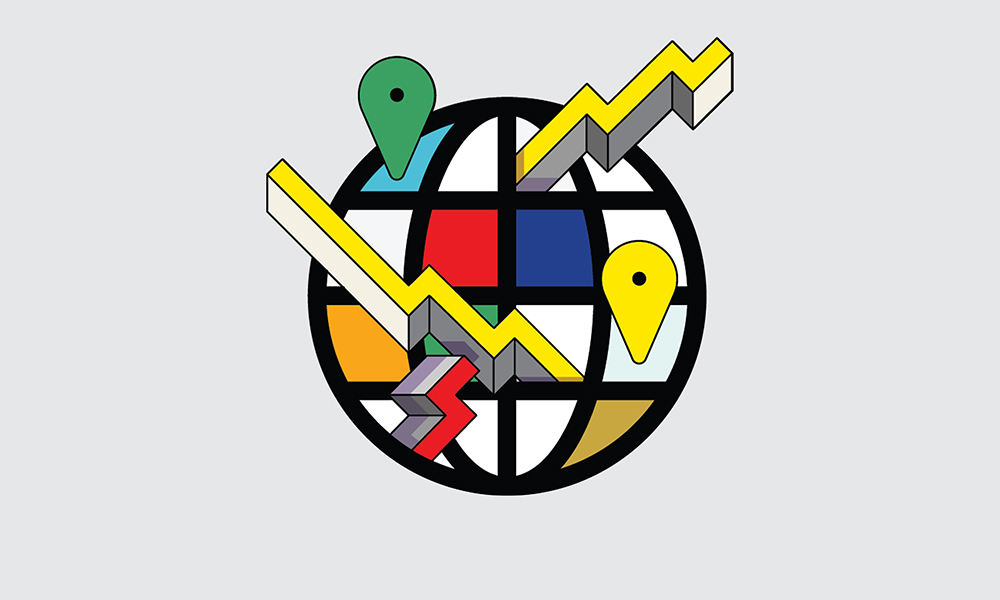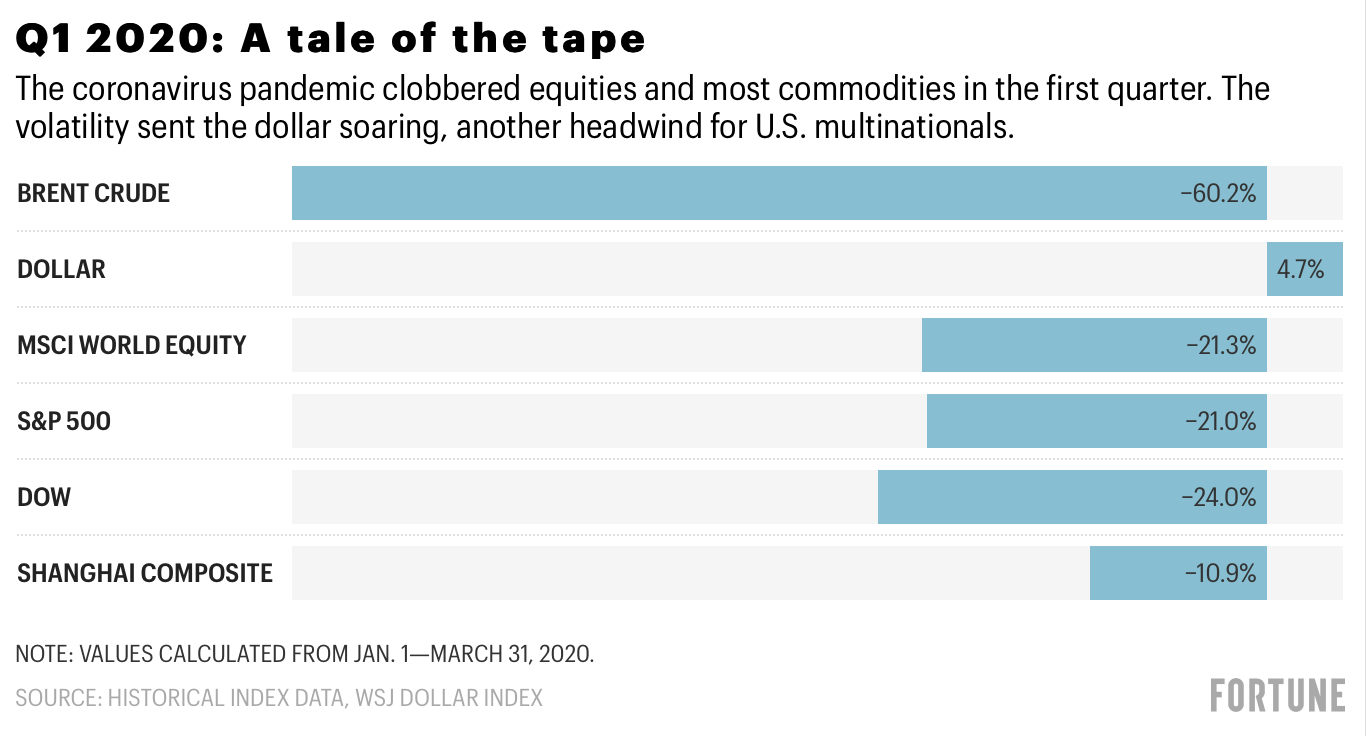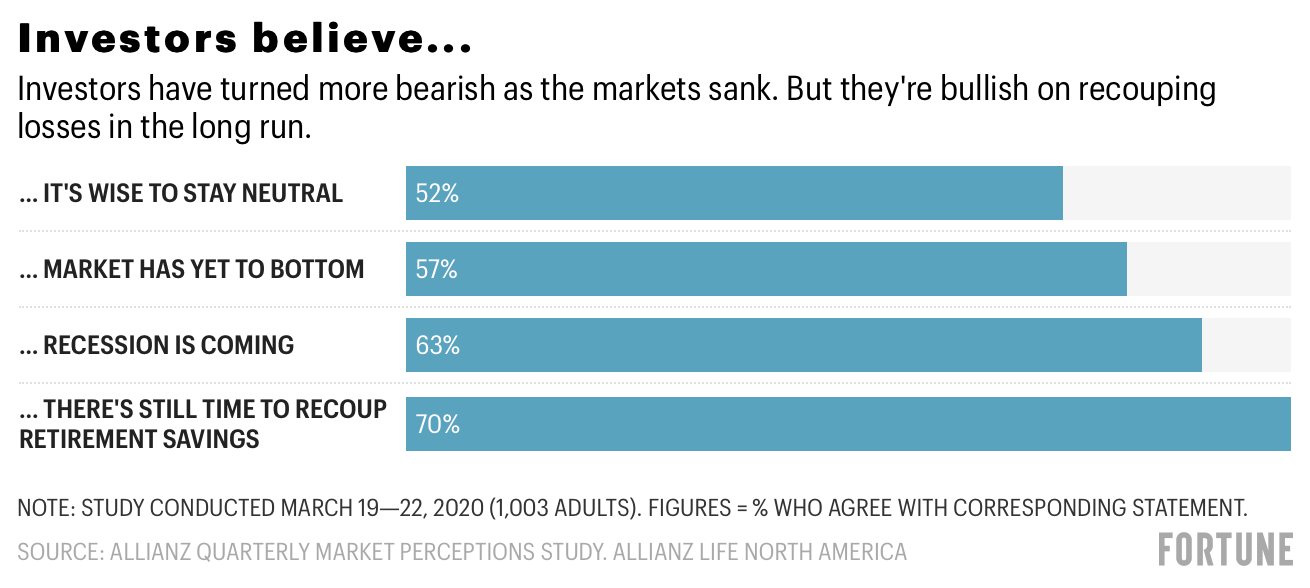 插图:JAMIE CULLEN
插图:JAMIE CULLEN你正坐在沙发上看新闻。全是令人沮丧的消息。新冠肺炎感染者数量持续攀升,股市继续暴跌。你拿起手机看了看自己买的股票。唉!全在下跌!怎么办?
卖掉?
勇敢点,进场抄底?
继续持有?
每一种做法都可以看作是一种策略,但却很难让人感到安慰。
我们刚刚经历了史上最糟糕的第一季度。那是道琼斯指数自1987年以来表现最差的一个季度。1987年正是发生臭名昭著的“黑色星期一”股灾的那一年。标普500指数的糟糕表现,只有2008年金融危机最严重的时候才能与之“相媲美”。
而且不止是股市。大宗商品市场也难以幸免。由于全球出行禁令、工厂停工和全球劳动者居家隔离,原油价格下跌了60%。由于难以想象的零息债券成为可能,导致美国10年期国债收益率暴跌122个基点,这表明投资者陷入极度恐慌。市场在最糟糕的时候所要表达的信息已经很清楚:零回报总好过赔钱。
 图:2020年1季度,布伦特原油、美元、摩根士丹利资本国际全球股票指数、标准普尔500指数、道琼斯指数、上证综指的浮动情况。
图:2020年1季度,布伦特原油、美元、摩根士丹利资本国际全球股票指数、标准普尔500指数、道琼斯指数、上证综指的浮动情况。工厂停工和停止出行等举措,最大程度抑制了疫情传播,但却让原油期货和全球股市在第一季度大幅下跌。
但现在有一些好消息。虽然标普500指数在第一季度下跌了21%(见上图),但看看该指数在过去两周的表现你会有截然不同的发现。从3月23日收盘至4月6日收盘,标普500指数上涨了19%。真希望你听到了脑海中那个告诉你“勇敢点”的声音。
但在震荡行情中,事后评价自己的行为没有任何意义。即使专业人士也会犯错。更重要的是,99.99%的投资者并不是专业人士。所以不要自责了!
纽约大学斯特恩商学院的经济学教授尼古拉斯·伊科诺米季斯表示:“在金融市场,多数人并没有足够的专业知识。这并非他们的本职工作。”而且一场百年不遇的大疫情导致全球股市暴跌,很快你就会看到那些毫无经验的401(k)计划投资者在股市的浪潮中苦苦挣扎。
伊科诺米季斯有哪些建议?他表示,在当前的市场环境下,不要与鲨鱼一起游泳。等到风平浪静之后再下水:“为什么要观望?如果你没有专业知识,现在的任何动作可能让你全盘皆输,这是愚蠢的行为。”
每个投资者都有各自不同的风险状况。有的投资者有条件尝试预测反弹的时间,从而让自己的获利最大化。但有的投资者必须等到市场稳定在一定区间之后,再去计划下一步。
事实上,专家认为,不要尝试预测“反弹”或“上涨”的时间,更明智的做法是预测市场“平静”的时间,即从每日暴涨变成幅度较小但循序渐进的波动。
比如:多数市场观察员依旧在尝试预测市场低点,而不是它会涨到多高。因此,摩根大通分析师最近指出,波动性成为他们日益重要的一个指标。分析师们最近专门研究了芝加哥期权交易所波动率指数,并将该指数与新冠肺炎感染人数和死亡人数相匹配。他们通过微积分运算得出标普500指数的最低点在2,100点左右(标普500指数在3月份第三周跌至2,193点,最接近这一水平,但之后开始反弹)。
我知道你在想什么。2100点?现在比2100点高出了20%以上。我们还会下跌到那个水平吗?
请记住:熊市的平均跌幅为32.7%。在所有熊市中下跌幅度最大的是上一次,即从2007年至2009年全球金融危机最严重的时期。这一次,标普指数从最高点至最低点的跌幅为34.1%;但从3月23日跌至最低点至今,标普指数已经收复了超过一半失地。
第二季度会带来什么?
第一季度出现了各种极端行情。标普500指数在2月份涨至历史新高,不到两周后就跌入了回调区间。但最终它却以强劲的表现结束了第一季度。目前还有许多问题值得担忧,比如创纪录的失业率、全球经济衰退以及距离结束遥遥无期的全球致命疫情。
现在的市场并不适合追求短期回报。但从长远来看,市场依旧会强势上扬。
安联人寿高级市场副总裁凯利·拉维尼表示:“过去几周,美国投资者眼看着他们的投资和退休储蓄大幅缩水,他们或许会想是否应该采取行动止血。好消息是对于多数人而言,还是理智占了上风,许多人似乎清楚,他们必须有长远眼光,尽量渡过难关。”
最新一期安联季度市场认知研究询问了投资者对未来的态度。结果显示,并不是所有人都是悲观的心态。大部分(63%)受访者表示他们担心经济衰退,超过一半(52%)受访者表示他们现在非常焦虑,不敢继续投资。
 图:3月19-22日进行的调查发现,52%的受访者认为应按兵不动,57%认为市场还未见底,63%认为衰退正在来临,70%认为有时间重新增加他们的退休储蓄金。
图:3月19-22日进行的调查发现,52%的受访者认为应按兵不动,57%认为市场还未见底,63%认为衰退正在来临,70%认为有时间重新增加他们的退休储蓄金。但从整体来看,投资者的情绪更为乐观。报告称:“接近70%的投资者认为,即使市场继续下跌,他们也有时间重新增加他们的退休储蓄金。”
大部分投资者可以带着这种情绪坚持下去。(财富中文网)
译者:BIZ
你正坐在沙发上看新闻。全是令人沮丧的消息。新冠肺炎感染者数量持续攀升,股市继续暴跌。你拿起手机看了看自己买的股票。唉!全在下跌!怎么办?
卖掉?
勇敢点,进场抄底?
继续持有?
每一种做法都可以看作是一种策略,但却很难让人感到安慰。
我们刚刚经历了史上最糟糕的第一季度。那是道琼斯指数自1987年以来表现最差的一个季度。1987年正是发生臭名昭著的“黑色星期一”股灾的那一年。标普500指数的糟糕表现,只有2008年金融危机最严重的时候才能与之“相媲美”。
而且不止是股市。大宗商品市场也难以幸免。由于全球出行禁令、工厂停工和全球劳动者居家隔离,原油价格下跌了60%。由于难以想象的零息债券成为可能,导致美国10年期国债收益率暴跌122个基点,这表明投资者陷入极度恐慌。市场在最糟糕的时候所要表达的信息已经很清楚:零回报总好过赔钱。
工厂停工和停止出行等举措,最大程度抑制了疫情传播,但却让原油期货和全球股市在第一季度大幅下跌。
但现在有一些好消息。虽然标普500指数在第一季度下跌了21%(见上图),但看看该指数在过去两周的表现你会有截然不同的发现。从3月23日收盘至4月6日收盘,标普500指数上涨了19%。真希望你听到了脑海中那个告诉你“勇敢点”的声音。
但在震荡行情中,事后评价自己的行为没有任何意义。即使专业人士也会犯错。更重要的是,99.99%的投资者并不是专业人士。所以不要自责了!
纽约大学斯特恩商学院的经济学教授尼古拉斯·伊科诺米季斯表示:“在金融市场,多数人并没有足够的专业知识。这并非他们的本职工作。”而且一场百年不遇的大疫情导致全球股市暴跌,很快你就会看到那些毫无经验的401(k)计划投资者在股市的浪潮中苦苦挣扎。
伊科诺米季斯有哪些建议?他表示,在当前的市场环境下,不要与鲨鱼一起游泳。等到风平浪静之后再下水:“为什么要观望?如果你没有专业知识,现在的任何动作可能让你全盘皆输,这是愚蠢的行为。”
每个投资者都有各自不同的风险状况。有的投资者有条件尝试预测反弹的时间,从而让自己的获利最大化。但有的投资者必须等到市场稳定在一定区间之后,再去计划下一步。
事实上,专家认为,不要尝试预测“反弹”或“上涨”的时间,更明智的做法是预测市场“平静”的时间,即从每日暴涨变成幅度较小但循序渐进的波动。
比如:多数市场观察员依旧在尝试预测市场低点,而不是它会涨到多高。因此,摩根大通分析师最近指出,波动性成为他们日益重要的一个指标。分析师们最近专门研究了芝加哥期权交易所波动率指数,并将该指数与新冠肺炎感染人数和死亡人数相匹配。他们通过微积分运算得出标普500指数的最低点在2,100点左右(标普500指数在3月份第三周跌至2,193点,最接近这一水平,但之后开始反弹)。
我知道你在想什么。2100点?现在比2100点高出了20%以上。我们还会下跌到那个水平吗?
请记住:熊市的平均跌幅为32.7%。在所有熊市中下跌幅度最大的是上一次,即从2007年至2009年全球金融危机最严重的时期。这一次,标普指数从最高点至最低点的跌幅为34.1%;但从3月23日跌至最低点至今,标普指数已经收复了超过一半失地。
第二季度会带来什么?
第一季度出现了各种极端行情。标普500指数在2月份涨至历史新高,不到两周后就跌入了回调区间。但最终它却以强劲的表现结束了第一季度。目前还有许多问题值得担忧,比如创纪录的失业率、全球经济衰退以及距离结束遥遥无期的全球致命疫情。
现在的市场并不适合追求短期回报。但从长远来看,市场依旧会强势上扬。
安联人寿高级市场副总裁凯利·拉维尼表示:“过去几周,美国投资者眼看着他们的投资和退休储蓄大幅缩水,他们或许会想是否应该采取行动止血。好消息是对于多数人而言,还是理智占了上风,许多人似乎清楚,他们必须有长远眼光,尽量渡过难关。”
最新一期安联季度市场认知研究询问了投资者对未来的态度。结果显示,并不是所有人都是悲观的心态。大部分(63%)受访者表示他们担心经济衰退,超过一半(52%)受访者表示他们现在非常焦虑,不敢继续投资。
但从整体来看,投资者的情绪更为乐观。报告称:“接近70%的投资者认为,即使市场继续下跌,他们也有时间重新增加他们的退休储蓄金。”
大部分投资者可以带着这种情绪坚持下去。(财富中文网)
译者:BIZ
ILLUSTRATION BY JAMIE CULLEN
You’re sitting on the couch watching the news. It’s depressing. Coronavirus infections are climbing, the markets are sinking. You reach for your smartphone to check on your portfolio. Gulp. Red flashes across the tiny screen. What do you do?
Sell?
Be bold, and buy on the dip?
Hold tight?
All three moves qualify as a strategy, but that’s hardly comforting.
We just came out of the worst first quarter ever. It was the Dow’s weakest quarter overall since 1987, the year of the infamous Black Monday crash. And you have to go back to the height of the 2008 financial crisis to find a stretch this bad for the S&P 500.
And it wasn’t just equities. Commodities tanked. Crude fell 60% as global travel ground to a halt, factories went on lockdown, and the global workforce slept in, with nowhere to go. In a sign of extreme investor jitters, the yield on 10-year Treasury notes bombed downward 122 basis points as the unthinkable—zero-bearing rates—became a distinct possibility. At its worst, what the markets were saying was clear: a return of zero beats losses.
The move to shutter factories and ground global travel to minimize the spread of the coronavirus outbreak sank crude oil futures and global equities in the first quarter.
But now, here’s some good news. While the S&P 500 fell 21% in the first quarter (see chart), the performance over the past two weeks shows a far different story. Between the March 23 close and the April 6 close, the S&P 500 is up 19%. If only you had listened to that voice saying, “Be bold.”
But in a volatile market, it makes no sense to second-guess your moves. Even the pros get it wrong. And, more important, 99.99% of investors are not professionals themselves. So stop kicking yourself!
“Most people don’t have enough expertise in financial markets. It’s not their job,” says Nicholas Economides, a professor of economics at NYU Stern School of Business. Add a once-in-a-lifetime pandemic that causes a global crash, and you quickly see armchair 401(k) investors are in over their head in choppy waters.
What does Economides advise? In markets like this, he says, don’t swim with the sharks. Wait for calmer waters: “Why wait and see? If you don’t have expertise in something, it’s kind of foolish taking action that could be completely wrong.”
Every investor’s risk profile is different. Some can afford to try to time the rebound to maximize the gains. Others will have to wait until the markets settle into a range before plotting the next move.
In fact, experts say, rather than timing the “rally” or the “upswing,” a better move is to time the “calm,” the point when the wild daily spikes flatten to more progressive—even dull—moves.
Consider: Most market watchers are still trying to figure out how low this market can go, not how high it will soar. As such, JPMorgan Chase analysts recently noted that volatility has become an increasingly big metric for them. They watch the Cboe Volatility Index intently and match that with the coronavirus infection and death numbers. That calculus helped them arrive at a floor for the S&P 500 at around 2,100 (the closest the index came to that was 2,193 in the third week of March, before climbing).
I know what you’re thinking. 2,100? We’re more than 20% above that right now. Could we fall back to that point?
Keep in mind: Bear markets have, on average, fallen by 32.7%. The deepest of all bears was the last one—spanning from 2007 to the depths of the global financial crisis in 2009. This time around, the S&P peak-to-trough drop was 34.1%; it’s recouped more than half that since the March 23 bottom.
What will Q2 bring?
The first quarter was marked by extremes. The S&P 500 hit an all-time high in February, and less than two weeks later was in correction territory. It then finished the quarter on a strong run. And yet there are a lot of concerns: record unemployment, a global recession, and a deadly global pandemic that hasn’t yet run its full course.
It’s not a market for short-term returns. But the longer term view looks strong.
“Americans who have watched their investments and retirement savings plummet over the past few weeks might be wondering if they should take action to stem the bleeding,” said Kelly LaVigne, vice president of advanced markets for Allianz Life. “The good news is that, for the majority, calmer heads prevail, and many seem to understand that they need to take a longer-term view and try to ride it out.”
The latest Allianz Quarterly Market Perceptions Study asked investors how they feel about the future. It wasn’t all doom and gloom. A majority of respondents (63%) say they are worried about a recession, and over half (52%) say they’re too unnerved to jump back in and invest.
But zoom out a bit, and the sentiment gets more positive. “Nearly 70% believe that, even if the market continues to decline, they will have time to rebuild their retirement savings,” the report notes.
A sentiment most investors can live by.






